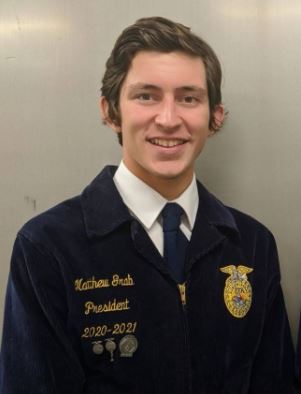Mon, 5 April 2021
INTRODUCING MATTHEW GRAB: You may wonder how we can produce so much food in the United States on an ever-shrinking footprint of ground with fewer and fewer people being involved in production agriculture. The answer is the natural curiosity of the American Farmer coupled with a passion for agriculture and an innovative mind. These characteristics that have made the American Farmer great are evident throughout the spectrum, from the 80-year-old farmer who is trying hard not to retire to the 16-year-old who is dreaming of how they can become a farmer. In today's interview, I am lucky enough to interview one of these farmers. At age 18, Matthew Grab is already accomplishing amazing things in the FFA and in agriculture. He lives on his family's grain farm in Freeburg, Illinois and one of the crops they grow is soybeans. As part of Matthew's supervised agricultural experience, he and a friend decided to see how hail damage would impact the yield on soybeans. The two of them set up a test plot of soybeans to experiment on, but the question was, how were they going to replicate hail? A very fun and innovative solution was thought up. They would shoot the soybean plants with a shotgun from a distance to simulate hail stones comes down and ripping the soybean leaves. Their initial hypothesis was that hail damage would decrease yield. This is a very natural hypothesis. However, they ended up demonstrating that at the stage of development that they simulated the damage the yield wound up increasing. This was very interesting, so the next year they replicated the experiment on a larger scale using a herbicide at a very low rate. This also increased the yield. They entered this experiment into the FFA's National Agriscience Fair, and they won! It is this type of natural curiosity and love for what they do that has always led the American Farmer to produce more with less. And it is this type of innovation and spirit in Matthew's generation that gives me the confidence to know that we will find a way to continue to feed the world as our world's population continues to grow.
Direct download: OFI_1037__Shotguns__Curiosity__Agriscience_Research___FFA_SAE_Edition___Matthew_Grab___Freeburg_Community_High_School_FFA.mp3
Category:FFA -- posted at: 12:30am MDT |
Off-Farm Income

Categories
generalfarming
FFA
rural crime
vicuna
Agricultural Colleges
Archives
AprilMarch
February
January
December
November
October
September
August
July
June
May
April
March
February
January
December
November
October
September
August
July
June
May
April
March
February
January
December
November
October
September
August
July
June
May
April
March
February
January
December
November
October
September
August
July
June
May
April
March
February
January
December
November
October
September
August
July
June
May
April
March
February
January
December
November
October
September
August
July
June
May
April
March
February
January
December
November
October
September
August
July
June
May
April
March
February
January
December
November
October
September
August
July
June
May
April
March
February
January
December
November
October
September
August
July
June
May
April
March
February
January
December
November
| S | M | T | W | T | F | S |
|---|---|---|---|---|---|---|
| 1 | 2 | 3 | ||||
| 4 | 5 | 6 | 7 | 8 | 9 | 10 |
| 11 | 12 | 13 | 14 | 15 | 16 | 17 |
| 18 | 19 | 20 | 21 | 22 | 23 | 24 |
| 25 | 26 | 27 | 28 | 29 | 30 | |
Syndication


